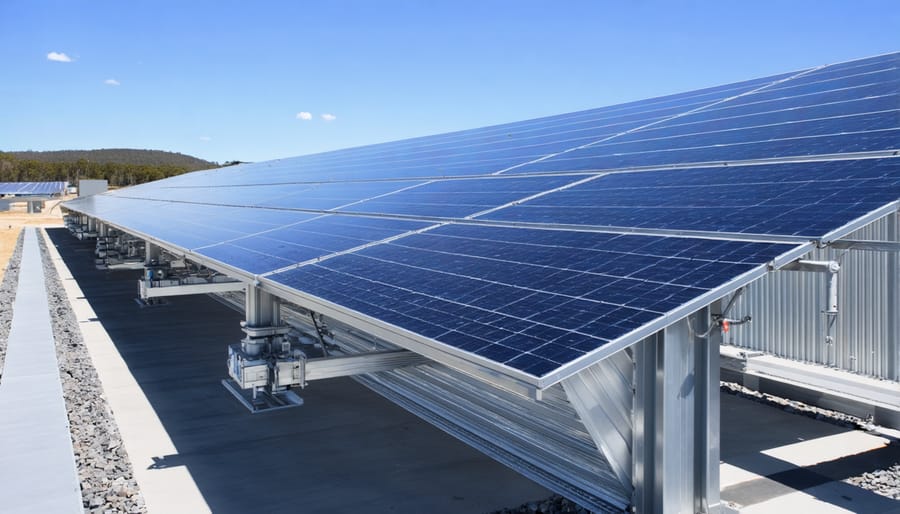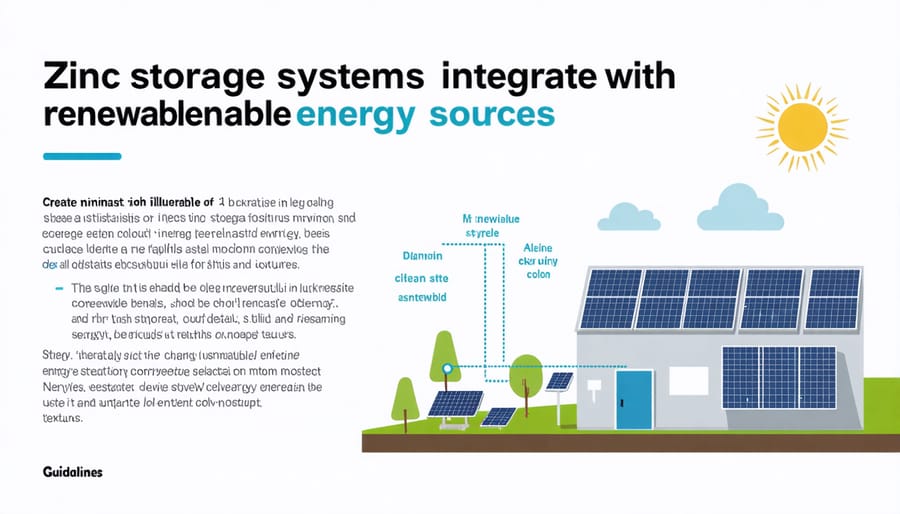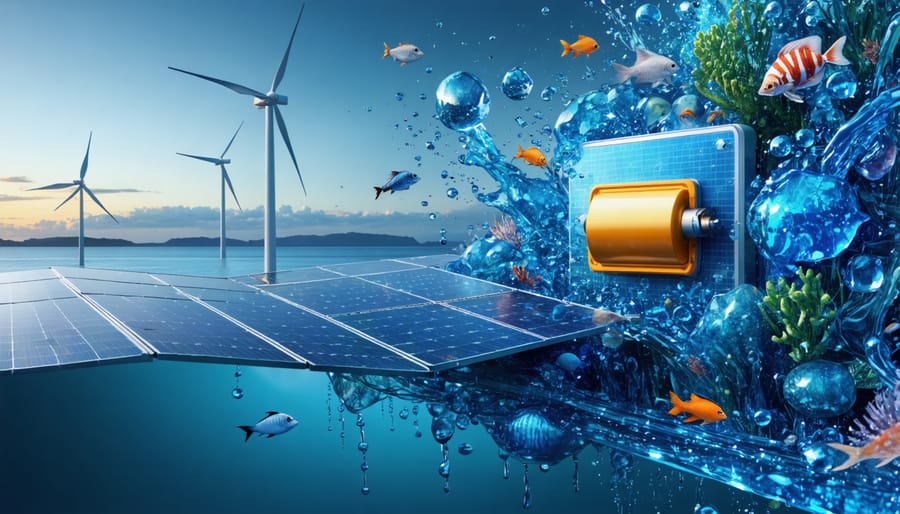In the race to revolutionize energy storage technologies, zinc-based systems are emerging as Australia’s most promising sustainable solution. This abundant metal, costing just one-thirtieth the price of lithium, is transforming how we store renewable energy across the continent. Unlike traditional batteries, zinc-based storage systems offer remarkable stability in extreme temperatures, making them ideal for Australia’s harsh climate – from the scorching Outback to coastal regions.
Drawing inspiration from nature’s own zinc-storing mechanisms found in marine life, these systems can operate safely in seawater, opening up unprecedented possibilities for coastal energy storage. With an estimated 100-year supply of zinc within Australian borders and a fully recyclable lifecycle, this technology represents not just an environmental victory, but a strategic advantage in our nation’s journey toward energy independence.
As solar and wind installations continue to multiply across the country, zinc-based storage solutions are proving to be the missing link in our renewable energy puzzle, providing the reliable, cost-effective, and environmentally sound storage capacity we urgently need.
Bio-Inspired Zinc Energy Storage: Learning from Nature’s Design
Natural Zinc Storage in Living Systems
Nature has perfected zinc storage mechanisms over millions of years of evolution, offering valuable insights for modern energy storage solutions. Plants and animals have developed sophisticated biological systems to manage zinc, which is essential for various life processes.
In plants, specialized proteins called metallothioneins act as natural zinc storage units, binding and releasing zinc as needed for growth and development. These proteins help plants maintain optimal zinc levels while protecting them from potential toxicity. Similarly, certain fungi species can accumulate high concentrations of zinc in their cell walls, demonstrating nature’s efficient storage capabilities.
In the animal kingdom, zinc storage is particularly fascinating. Oysters, for instance, can concentrate zinc at levels up to 2000 times higher than their surrounding seawater. The human body also maintains precise zinc homeostasis through specialized transport proteins and storage mechanisms in organs like the liver.
These natural systems have inspired scientists to develop bio-inspired zinc storage technologies, combining nature’s wisdom with modern engineering. By understanding and adapting these biological processes, we’re creating more efficient and environmentally friendly energy storage solutions.

Translating Biological Principles to Technology
Nature has always been our greatest teacher, and in the realm of bio-inspired energy solutions, zinc storage systems are no exception. Scientists have found fascinating parallels between how living organisms manage zinc and how we can design better batteries. Marine organisms like oysters and certain types of algae have evolved sophisticated mechanisms to store and process zinc efficiently, maintaining perfect balance even in challenging environments.
These natural systems have inspired breakthrough developments in zinc battery technology. For instance, the way zinc is transported and stored in plant cells has led to innovations in electrode design, improving battery efficiency and longevity. The protective layers found in shellfish that prevent zinc corrosion have prompted researchers to develop similar protective coatings for zinc batteries, significantly extending their lifespan.
Australian researchers are particularly interested in these biomimetic approaches, as they offer solutions well-suited to our unique climate conditions. By studying how native species handle zinc storage, we’re developing storage systems that are more resilient, sustainable, and adapted to local environmental challenges.
Australian Innovation in Zinc Storage Technology
Local Research Breakthroughs
Australian researchers have been making remarkable strides in zinc energy storage technology, with several breakthrough developments emerging from our leading institutions. The University of Sydney’s team recently developed a novel zinc-air battery system that demonstrates unprecedented stability and rechargeability, marking a significant advancement in sustainable energy storage solutions.
At CSIRO’s Energy Centre in Newcastle, scientists have successfully created a zinc-based flow battery that operates efficiently at room temperature, addressing one of the key challenges in traditional zinc battery systems. This innovation has caught the attention of industry partners, with pilot projects already underway in regional New South Wales.
Queensland researchers have taken a different approach, drawing inspiration from marine organisms that naturally process zinc. Their bio-inspired electrode design has shown promising results in laboratory tests, achieving energy density levels that rival lithium-ion batteries while using more abundant and environmentally friendly materials.
The Melbourne Energy Institute has focused on scaling up zinc storage technology for industrial applications. Their recent breakthrough in electrode manufacturing techniques has reduced production costs by 40%, making zinc storage systems increasingly competitive in the commercial market.
These local innovations are particularly significant for Australia’s renewable energy landscape, as they offer a domestic solution that leverages our abundant zinc resources while providing a safer, more sustainable alternative to conventional battery technologies.
Real-World Applications
Several pioneering projects across Australia demonstrate the remarkable potential of zinc energy storage systems. In South Australia, the Tonsley Innovation District has successfully implemented a zinc-bromine flow battery system that provides reliable backup power for critical facilities while reducing peak demand charges. This installation has shown impressive results, with a 40% reduction in energy costs during its first year of operation.
In regional Queensland, a remote mining operation has embraced zinc energy storage to complement its solar array, effectively creating a sustainable microgrid. The system stores excess solar energy during daylight hours and provides consistent power throughout the night, reducing diesel consumption by approximately 60%.
The Western Australian town of Esperance showcases another successful implementation, where a community-scale zinc energy storage facility helps stabilize the local grid and integrate renewable energy sources. This installation has proven particularly valuable during peak tourist seasons when energy demand fluctuates significantly.
Perhaps most notably, the Byron Bay Industrial Estate in New South Wales has incorporated a large-scale zinc storage system that serves multiple businesses. This collaborative approach has not only improved energy reliability but has also created a model for other industrial precincts to follow. The system has demonstrated 98% efficiency in energy storage and distribution, while requiring minimal maintenance over its first two years of operation.
These real-world applications highlight the adaptability and effectiveness of zinc energy storage across various Australian contexts, from urban developments to remote operations.

Environmental and Economic Benefits
Sustainability Advantages
Zinc-based energy storage systems offer remarkable environmental advantages that make them a standout choice for modern renewable energy systems. Unlike traditional lithium-ion batteries, zinc-based storage solutions rely on abundant, naturally occurring materials that are readily available in Australia and around the globe. This accessibility significantly reduces the environmental impact of mining and transportation associated with battery production.
One of the most compelling sustainability benefits is zinc’s highly recyclable nature. At the end of their lifecycle, zinc batteries can be almost entirely recycled, creating a circular economy that minimizes waste and reduces the need for continuous raw material extraction. This recyclability aligns perfectly with Australia’s growing commitment to sustainable resource management.
The environmental footprint of zinc battery production is notably smaller compared to conventional alternatives. The manufacturing process requires less energy and produces fewer greenhouse gas emissions. Additionally, zinc-based systems don’t contain toxic materials like lead or cadmium, making them safer for both the environment and human health.
Water consumption during production is another area where zinc storage systems shine. The manufacturing process uses significantly less water compared to lithium-ion batteries, a crucial advantage in Australia’s drought-prone climate. The systems are also fire-resistant and operate at ambient temperatures, eliminating the need for energy-intensive cooling systems.
Perhaps most importantly, zinc storage solutions support the broader transition to clean energy by providing reliable, sustainable storage for intermittent renewable sources. This capability helps reduce our dependence on fossil fuels while ensuring a stable and environmentally friendly energy supply for future generations.
Cost-Effectiveness and Accessibility
When it comes to energy storage solutions, zinc-based systems are emerging as a cost-competitive alternative to traditional lithium-ion batteries. The abundance of zinc in Australia’s mineral deposits makes it an especially attractive option for our renewable energy future. Current estimates suggest that zinc energy storage systems can be produced at roughly half the cost of equivalent lithium-ion installations, primarily due to the lower material costs and simpler manufacturing processes.
The accessibility of zinc as a resource is particularly noteworthy, with Australia being home to some of the world’s largest zinc reserves. This local availability not only reduces transportation costs but also strengthens our domestic energy security. Mining companies in Queensland and Northern Territory are already positioning themselves to meet the growing demand for zinc in energy storage applications.
From a practical standpoint, zinc storage systems require minimal specialized infrastructure for installation and maintenance. Local electricians and technicians can be readily trained to work with these systems, creating job opportunities while keeping ongoing maintenance costs manageable. The systems are also scalable, making them suitable for both residential installations and large-scale industrial applications.
Recent pilot projects in regional communities have demonstrated that zinc storage solutions can be particularly cost-effective for remote areas, where traditional grid infrastructure is expensive to maintain. These systems have shown promising results in providing reliable backup power at about 30% lower lifecycle costs compared to conventional alternatives.
The market potential for zinc energy storage is substantial, with industry analysts projecting significant growth over the next decade. As manufacturing scales up and technology improves, costs are expected to decrease further, making zinc storage an increasingly attractive option for Australia’s clean energy transition.
Future Prospects and Integration
Emerging Technologies
The landscape of zinc energy storage is rapidly evolving, with several groundbreaking technologies emerging from research labs across Australia and worldwide. One of the most promising developments is the zinc-air flow battery, which combines the stability of zinc with the abundance of oxygen from the air. These systems are showing remarkable potential for grid-scale storage, particularly in remote Australian communities.
Recent innovations include the development of advanced zinc-bromide hybrid batteries, which offer exceptional stability and longevity. Australian researchers have successfully created new electrode materials that significantly reduce dendrite formation – a common challenge in zinc-based batteries – while improving overall efficiency.
Another exciting breakthrough is the integration of nanotechnology in zinc storage systems. Scientists have engineered nano-structured zinc particles that increase the surface area for reactions, leading to faster charging times and higher energy density. This advancement could revolutionize both stationary storage and mobile applications.
Smart manufacturing techniques are also transforming zinc battery production. 3D printing of zinc electrodes has emerged as a game-changer, allowing for customized designs that optimize performance while reducing manufacturing costs. These innovations are particularly relevant for Australia’s renewable energy sector, where cost-effective storage solutions are crucial for supporting solar and wind power integration.
Most notably, researchers are developing bio-inspired zinc storage systems that mimic natural processes found in marine organisms, promising even greater sustainability and efficiency in future energy storage solutions.

Integration with Renewable Energy
Zinc energy storage systems are proving to be ideal companions for renewable energy sources, particularly in Australia’s rapidly evolving energy landscape. These systems excel at smoothing out the intermittent nature of wind and solar power, ensuring a steady power supply even when the sun isn’t shining or the wind isn’t blowing.
The versatility of zinc storage technology makes it particularly well-suited for solar power integration, especially in remote Australian communities where reliable energy storage is crucial. Unlike traditional batteries, zinc storage systems can handle the variable output from renewable sources without degrading, making them perfect for long-term energy management.
What makes zinc storage particularly valuable is its ability to respond quickly to sudden changes in renewable energy generation. When clouds pass over solar panels or wind speeds fluctuate, zinc storage systems can instantly bridge the gap, maintaining consistent power delivery to the grid. This responsiveness helps stabilize the entire energy network, making renewable energy more reliable and practical for everyday use.
In rural Australia, where many communities are transitioning to renewable energy, zinc storage systems are proving their worth by enabling greater adoption of solar and wind power. These systems can store excess energy generated during peak production periods and release it when needed, effectively turning intermittent renewable sources into dependable, around-the-clock power supplies.
As we look towards Australia’s renewable energy future, bio-inspired zinc storage systems stand out as a beacon of innovation and sustainability. Drawing from nature’s own elegant solutions, these systems offer a compelling pathway to address our nation’s energy storage challenges while maintaining harmony with our unique environment.
The potential of zinc-based storage extends far beyond its technical capabilities. By adopting these bio-inspired solutions, we’re not just storing energy – we’re embracing a technology that aligns perfectly with Australia’s commitment to clean energy and environmental stewardship. From remote communities in the Outback to bustling urban centers along our coastlines, zinc storage systems offer a versatile, safe, and environmentally friendly option for our diverse energy needs.
The future looks particularly promising as research continues to advance and costs decrease. With abundant zinc resources and growing expertise in renewable technologies, Australia is well-positioned to become a global leader in this field. The integration of these systems into our existing renewable infrastructure could create thousands of green jobs while supporting our transition to a carbon-neutral economy.
As we face the challenges of climate change, bio-inspired zinc storage represents more than just an energy solution – it’s a testament to our ability to learn from nature and adapt its wisdom to create a more sustainable future. By embracing these innovative technologies, we’re not just powering our homes and businesses; we’re investing in a cleaner, greener tomorrow for generations to come.

